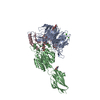[English] 日本語
 Yorodumi
Yorodumi- PDB-9ef2: Cryo-EM structure of alpha5beta1 integrin in complex with NeoNect... -
+ Open data
Open data
- Basic information
Basic information
| Entry | Database: PDB / ID: 9ef2 | |||||||||||||||
|---|---|---|---|---|---|---|---|---|---|---|---|---|---|---|---|---|
| Title | Cryo-EM structure of alpha5beta1 integrin in complex with NeoNectin candidate 2, open conformation | |||||||||||||||
 Components Components |
| |||||||||||||||
 Keywords Keywords | SIGNALING PROTEIN / a5B1 / de novo / tissue regeneration / extracellular matrix protein | |||||||||||||||
| Function / homology |  Function and homology information Function and homology informationintegrin alpha8-beta1 complex / integrin alpha3-beta1 complex / integrin alpha5-beta1 complex / integrin alpha6-beta1 complex / integrin alpha7-beta1 complex / integrin alpha10-beta1 complex / integrin alpha11-beta1 complex / positive regulation of glutamate uptake involved in transmission of nerve impulse / myoblast fate specification / integrin alpha9-beta1 complex ...integrin alpha8-beta1 complex / integrin alpha3-beta1 complex / integrin alpha5-beta1 complex / integrin alpha6-beta1 complex / integrin alpha7-beta1 complex / integrin alpha10-beta1 complex / integrin alpha11-beta1 complex / positive regulation of glutamate uptake involved in transmission of nerve impulse / myoblast fate specification / integrin alpha9-beta1 complex / regulation of collagen catabolic process / cardiac cell fate specification / integrin alpha1-beta1 complex / integrin binding involved in cell-matrix adhesion / integrin alpha4-beta1 complex / cell-cell adhesion mediated by integrin / collagen binding involved in cell-matrix adhesion / integrin alpha2-beta1 complex / reactive gliosis / Localization of the PINCH-ILK-PARVIN complex to focal adhesions / formation of radial glial scaffolds / Other semaphorin interactions / cerebellar climbing fiber to Purkinje cell synapse / Formation of the ureteric bud / myelin sheath abaxonal region / CD40 signaling pathway / calcium-independent cell-matrix adhesion / Fibronectin matrix formation / positive regulation of fibroblast growth factor receptor signaling pathway / regulation of synapse pruning / integrin alphav-beta1 complex / CHL1 interactions / basement membrane organization / RUNX2 regulates genes involved in cell migration / cardiac muscle cell myoblast differentiation / MET interacts with TNS proteins / alphav-beta3 integrin-vitronectin complex / Laminin interactions / cardiac muscle cell differentiation / Platelet Adhesion to exposed collagen / germ cell migration / leukocyte tethering or rolling / vascular endothelial growth factor receptor 2 binding / cell projection organization / myoblast fusion / positive regulation of vascular endothelial growth factor signaling pathway / Elastic fibre formation / mesodermal cell differentiation / cell-substrate junction assembly / platelet-derived growth factor receptor binding / myoblast differentiation / axon extension / cell migration involved in sprouting angiogenesis / Differentiation of Keratinocytes in Interfollicular Epidermis in Mammalian Skin / positive regulation of vascular endothelial growth factor receptor signaling pathway / central nervous system neuron differentiation / positive regulation of cell-substrate adhesion / regulation of spontaneous synaptic transmission / heterophilic cell-cell adhesion / wound healing, spreading of epidermal cells / epidermal growth factor receptor binding / positive regulation of fibroblast migration / integrin complex / lamellipodium assembly / sarcomere organization / heterotypic cell-cell adhesion / MET activates PTK2 signaling / Basigin interactions / Molecules associated with elastic fibres / Mechanical load activates signaling by PIEZO1 and integrins in osteocytes / negative regulation of vasoconstriction / leukocyte cell-cell adhesion / muscle organ development / Syndecan interactions / cell adhesion mediated by integrin / positive regulation of wound healing / dendrite morphogenesis / negative regulation of neuron differentiation / positive regulation of neuroblast proliferation / negative regulation of Rho protein signal transduction / response to muscle activity / maintenance of blood-brain barrier / positive regulation of sprouting angiogenesis / cell-substrate adhesion / homophilic cell-cell adhesion / endodermal cell differentiation / TGF-beta receptor signaling activates SMADs / cleavage furrow / establishment of mitotic spindle orientation / fibronectin binding / negative regulation of anoikis / intercalated disc / cellular response to low-density lipoprotein particle stimulus / positive regulation of GTPase activity / RHOG GTPase cycle / glial cell projection / neuroblast proliferation / RAC2 GTPase cycle / RAC3 GTPase cycle / ECM proteoglycans Similarity search - Function | |||||||||||||||
| Biological species |  Homo sapiens (human) Homo sapiens (human)synthetic construct (others) | |||||||||||||||
| Method | ELECTRON MICROSCOPY / single particle reconstruction / cryo EM / Resolution: 3.36 Å | |||||||||||||||
 Authors Authors | Werther, R. / Nguyen, A. / Estrada Alamo, K.A. / Wang, X. / Campbell, M.G. | |||||||||||||||
| Funding support |  United States, 4items United States, 4items
| |||||||||||||||
 Citation Citation |  Journal: Adv Mater / Year: 2025 Journal: Adv Mater / Year: 2025Title: De Novo Design of Integrin α5β1 Modulating Proteins to Enhance Biomaterial Properties. Authors: Xinru Wang / Jordi Guillem-Marti / Saurav Kumar / David S Lee / Daniel Cabrerizo-Aguado / Rachel Werther / Kevin Alexander Estrada Alamo / Yan Ting Zhao / Adam Nguyen / Irina Kopyeva / Buwei ...Authors: Xinru Wang / Jordi Guillem-Marti / Saurav Kumar / David S Lee / Daniel Cabrerizo-Aguado / Rachel Werther / Kevin Alexander Estrada Alamo / Yan Ting Zhao / Adam Nguyen / Irina Kopyeva / Buwei Huang / Jing Li / Yuxin Hao / Xinting Li / Aritza Brizuela-Velasco / Analisa Murray / Stacey Gerben / Anindya Roy / Cole A DeForest / Timothy Springer / Hannele Ruohola-Baker / Jonathan A Cooper / Melody G Campbell / Jose Maria Manero / Maria-Pau Ginebra / David Baker /   Abstract: Integrin α5β1 is crucial for cell attachment and migration in development and tissue regeneration, and α5β1 binding proteins can have considerable utility in regenerative medicine and next- ...Integrin α5β1 is crucial for cell attachment and migration in development and tissue regeneration, and α5β1 binding proteins can have considerable utility in regenerative medicine and next-generation therapeutics. We use computational protein design to create de novo α5β1-specific modulating miniprotein binders, called NeoNectins, that bind to and stabilize the open state of α5β1. When immobilized onto titanium surfaces and throughout 3D hydrogels, the NeoNectins outperform native fibronectin (FN) and RGD peptides in enhancing cell attachment and spreading, and NeoNectin-grafted titanium implants outperformed FN- and RGD-grafted implants in animal models in promoting tissue integration and bone growth. NeoNectins should be broadly applicable for tissue engineering and biomedicine. | |||||||||||||||
| History |
|
- Structure visualization
Structure visualization
| Structure viewer | Molecule:  Molmil Molmil Jmol/JSmol Jmol/JSmol |
|---|
- Downloads & links
Downloads & links
- Download
Download
| PDBx/mmCIF format |  9ef2.cif.gz 9ef2.cif.gz | 188.7 KB | Display |  PDBx/mmCIF format PDBx/mmCIF format |
|---|---|---|---|---|
| PDB format |  pdb9ef2.ent.gz pdb9ef2.ent.gz | 128.4 KB | Display |  PDB format PDB format |
| PDBx/mmJSON format |  9ef2.json.gz 9ef2.json.gz | Tree view |  PDBx/mmJSON format PDBx/mmJSON format | |
| Others |  Other downloads Other downloads |
-Validation report
| Summary document |  9ef2_validation.pdf.gz 9ef2_validation.pdf.gz | 1.8 MB | Display |  wwPDB validaton report wwPDB validaton report |
|---|---|---|---|---|
| Full document |  9ef2_full_validation.pdf.gz 9ef2_full_validation.pdf.gz | 1.8 MB | Display | |
| Data in XML |  9ef2_validation.xml.gz 9ef2_validation.xml.gz | 40.1 KB | Display | |
| Data in CIF |  9ef2_validation.cif.gz 9ef2_validation.cif.gz | 59.3 KB | Display | |
| Arichive directory |  https://data.pdbj.org/pub/pdb/validation_reports/ef/9ef2 https://data.pdbj.org/pub/pdb/validation_reports/ef/9ef2 ftp://data.pdbj.org/pub/pdb/validation_reports/ef/9ef2 ftp://data.pdbj.org/pub/pdb/validation_reports/ef/9ef2 | HTTPS FTP |
-Related structure data
| Related structure data |  47968MC  9ckvC  9diaC C: citing same article ( M: map data used to model this data |
|---|---|
| Similar structure data | Similarity search - Function & homology  F&H Search F&H Search |
- Links
Links
- Assembly
Assembly
| Deposited unit | 
|
|---|---|
| 1 |
|
- Components
Components
-Protein , 3 types, 3 molecules ABC
| #1: Protein | Mass: 109695.867 Da / Num. of mol.: 1 Source method: isolated from a genetically manipulated source Source: (gene. exp.)  Homo sapiens (human) / Gene: ITGA5, FNRA / Cell line (production host): ExpiCHO / Production host: Homo sapiens (human) / Gene: ITGA5, FNRA / Cell line (production host): ExpiCHO / Production host:  |
|---|---|
| #2: Protein | Mass: 81743.961 Da / Num. of mol.: 1 Source method: isolated from a genetically manipulated source Source: (gene. exp.)  Homo sapiens (human) / Gene: ITGB1, FNRB, MDF2, MSK12 / Cell line (production host): ExpiCHO / Production host: Homo sapiens (human) / Gene: ITGB1, FNRB, MDF2, MSK12 / Cell line (production host): ExpiCHO / Production host:  |
| #3: Protein | Mass: 11152.550 Da / Num. of mol.: 1 Source method: isolated from a genetically manipulated source Source: (gene. exp.) synthetic construct (others) / Production host:  |
-Sugars , 4 types, 8 molecules 
| #4: Polysaccharide | | #5: Polysaccharide | alpha-D-mannopyranose-(1-3)-alpha-D-mannopyranose-(1-6)-[alpha-D-mannopyranose-(1-3)]beta-D- ...alpha-D-mannopyranose-(1-3)-alpha-D-mannopyranose-(1-6)-[alpha-D-mannopyranose-(1-3)]beta-D-mannopyranose-(1-4)-2-acetamido-2-deoxy-beta-D-glucopyranose-(1-4)-2-acetamido-2-deoxy-beta-D-glucopyranose | #6: Polysaccharide | 2-acetamido-2-deoxy-beta-D-glucopyranose-(1-4)-[alpha-L-fucopyranose-(1-6)]2-acetamido-2-deoxy-beta- ...2-acetamido-2-deoxy-beta-D-glucopyranose-(1-4)-[alpha-L-fucopyranose-(1-6)]2-acetamido-2-deoxy-beta-D-glucopyranose | Source method: isolated from a genetically manipulated source #8: Sugar | |
|---|
-Non-polymers , 2 types, 6 molecules 


| #7: Chemical | | #9: Chemical | |
|---|
-Details
| Has ligand of interest | N |
|---|---|
| Has protein modification | Y |
-Experimental details
-Experiment
| Experiment | Method: ELECTRON MICROSCOPY |
|---|---|
| EM experiment | Aggregation state: PARTICLE / 3D reconstruction method: single particle reconstruction |
- Sample preparation
Sample preparation
| Component | Name: Protein complex of wild type integrin alpha-5 beta-1 with computationally designed protein NeoNectin candidate 2 Type: COMPLEX / Entity ID: #1-#3 / Source: RECOMBINANT | ||||||||||||||||||||
|---|---|---|---|---|---|---|---|---|---|---|---|---|---|---|---|---|---|---|---|---|---|
| Molecular weight | Experimental value: NO | ||||||||||||||||||||
| Source (natural) | Organism:  Homo sapiens (human) Homo sapiens (human) | ||||||||||||||||||||
| Source (recombinant) | Organism:  | ||||||||||||||||||||
| Buffer solution | pH: 7.5 | ||||||||||||||||||||
| Buffer component |
| ||||||||||||||||||||
| Specimen | Conc.: 0.09 mg/ml / Embedding applied: NO / Shadowing applied: NO / Staining applied: NO / Vitrification applied: YES | ||||||||||||||||||||
| Vitrification | Instrument: FEI VITROBOT MARK IV / Cryogen name: ETHANE / Humidity: 100 % / Chamber temperature: 277 K |
- Electron microscopy imaging
Electron microscopy imaging
| Microscopy | Model: TFS GLACIOS |
|---|---|
| Electron gun | Electron source:  FIELD EMISSION GUN / Accelerating voltage: 200 kV / Illumination mode: FLOOD BEAM FIELD EMISSION GUN / Accelerating voltage: 200 kV / Illumination mode: FLOOD BEAM |
| Electron lens | Mode: BRIGHT FIELD / Nominal magnification: 36000 X / Nominal defocus max: 2000 nm / Nominal defocus min: 1000 nm / Cs: 2.7 mm |
| Specimen holder | Cryogen: NITROGEN |
| Image recording | Electron dose: 50 e/Å2 / Film or detector model: GATAN K3 (6k x 4k) / Num. of grids imaged: 1 / Details: Collection at 30 degrees tilt |
- Processing
Processing
| EM software | Name: PHENIX / Category: model refinement | ||||||||||||||||||||||||
|---|---|---|---|---|---|---|---|---|---|---|---|---|---|---|---|---|---|---|---|---|---|---|---|---|---|
| CTF correction | Type: PHASE FLIPPING AND AMPLITUDE CORRECTION | ||||||||||||||||||||||||
| 3D reconstruction | Resolution: 3.36 Å / Resolution method: FSC 0.143 CUT-OFF / Num. of particles: 63256 / Symmetry type: POINT | ||||||||||||||||||||||||
| Refine LS restraints |
|
 Movie
Movie Controller
Controller




 PDBj
PDBj

















